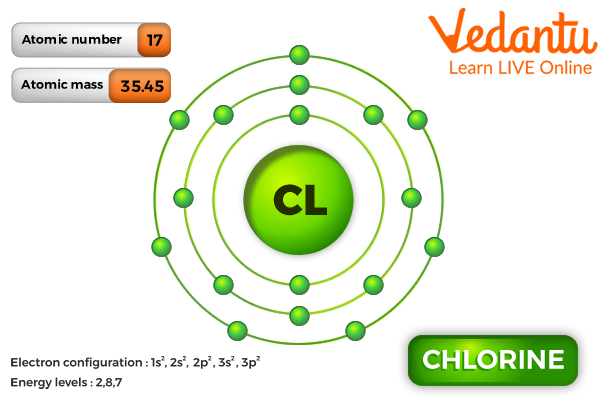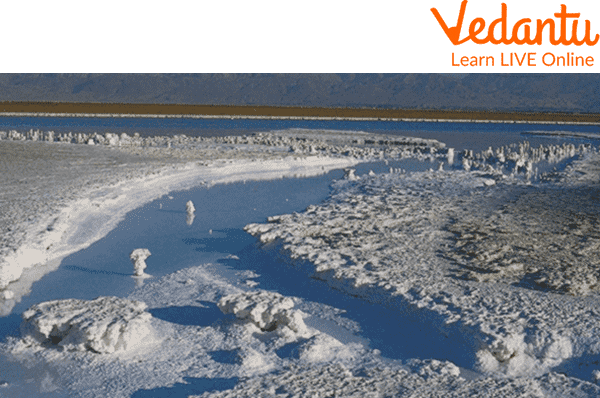




Why Chlorine Matters: Uses, Safety, and Exam Tips
Chlorine is an element that chemists mostly use. The world of Chemistry is filled with mysterious chemicals, and chlorine is one of them. There are a lot of interesting facts about chlorine that one would surely have no idea about. One of the simplest facts about chlorine is it is the second-lightest element in the halogen family. Chemistry could be boring for some but interesting for many.
Now, the atomic number of chlorine is 17. Every chemical in the periodic table has its atomic number, and so does chlorine. Interestingly, chlorine appears between fluorine and bromine in the periodic table. In the periodic table, this element will be symbolised as Cl. Now, let us learn more about chlorine, shall we?
What is Chlorine?
Chlorine is a chemical element that is not very friendly when it comes to human contact. It is one of the period table's toxic, corrosive chemical elements. The colour of chlorine or Cl is greenish yellow and it is always found in gas form. It might be found in gas form but, when in contact with the human body it becomes irritating. The eyes are where it irritates the most in the human body.
The household name of this chemical is rock salt. It has been known to humans for thousands of years now. Chlorine is the main constituent of the salts dissolved in seawater. The valency of chlorine is 1, and the atomic mass of chlorine is 35.466 to 35.457. On the other hand, the electronic configuration of chlorine is Ne3s23p5.

Atomic Number of Chlorine
Formation of Chlorine
We all surely have heard a lot about chlorine but, we have very little idea of where it is formed and distributed. Yes, you get chlorine gas or any of its elements free from nature but not in bulk. Chlorine is mostly found in the form of chemical compounds. This element compound is highly found in active volcanoes.
The natural chlorine found on the Earth is a mixture of two stable isotopes - they are chlorine-35 and chlorine-37 percent. The common form of chlorine found in every household is sodium chloride. It is found as crystalline rock salt or the common salt. Sodium chloride is highly present in various seawater such as the Caspian Sea, Dead Sea, and the Great Salt Lake of Utah.

Chlorine Formation
Interesting Facts About Chlorine
Chlorine when experimented with other gases or liquids it takes a different form. Scientists over the world have done thousands of experiments with this chemical element. Chlorine can be used for various daily-life purposes. Chlorine is one of the commonly manufactured chemical gases in the United States. Some of the interesting facts related to chlorine are the following:
Chlorine was the very first gas that was used during the first World War.
Chlorine gases are far denser than any other gases found on Earth.
When experimenting with charcoal, the combination of charcoal and chlorine takes place rapidly. A huge part of hydrogen will rapidly burn in chlorine giving a silvery flame colour.
The molecules present inside chlorine are only composed of two atoms and that is Cl2. This helps chlorine gas combine with almost every other element present in the periodic table. But, it does not mix well with the lighter noble gases.
Initially, chlorine was mostly mistaken for oxygen. One of the famous chemists Sir Humphry Davy first identified chlorine way back in 1811. Yes, pure chlorine was already known to humans way earlier.
This gas is slightly soluble in water and yields chlorine water. The solution coming from this experiment becomes a solid hydrate of ideal composition, Cl2.7.66H2O.
These were some of the interesting facts about chlorine. The use of chlorine has been coming for more than a hundred years now commercially. This gas is quite efficient for factory workers and the manufacturing industry around the world.
Summary
From using chlorine against humans in World War I to cleaning water for humans, the uses of chlorine have evolved. Today, the uses of chlorine have become a long list for people in the world. Chlorine might occur rarely in nature but, it is the third-most abundant element found in the Earth’s oceans. Moreover, now we have learnt some facts about chlorine, the atomic number, the valency of chlorine, the atomic mass of chlorine, and the electronic configuration of chlorine. We hope you have understood everything about chlorine.
FAQs on Fascinating Facts About Chlorine
1. Why is chlorine so poisonous when contacted with the human body?
Chlorine rapidly reacts with water present outside the body on a mucosal surface. It includes the water present inside the digestive tract. Now, when it reacts hydrochloric acid and hypochlorous acid is formed.
2. What does chlorine do to our brain when exposed too much?
When chlorine is overexposed to the human brain it will impair neurobehavioral functions. Other than that, it will elevate the POMS scores and increase other symptoms.
3. Is chlorine known to be a bleach?
Chlorine is not bleach but, bleach contains chlorine.





















